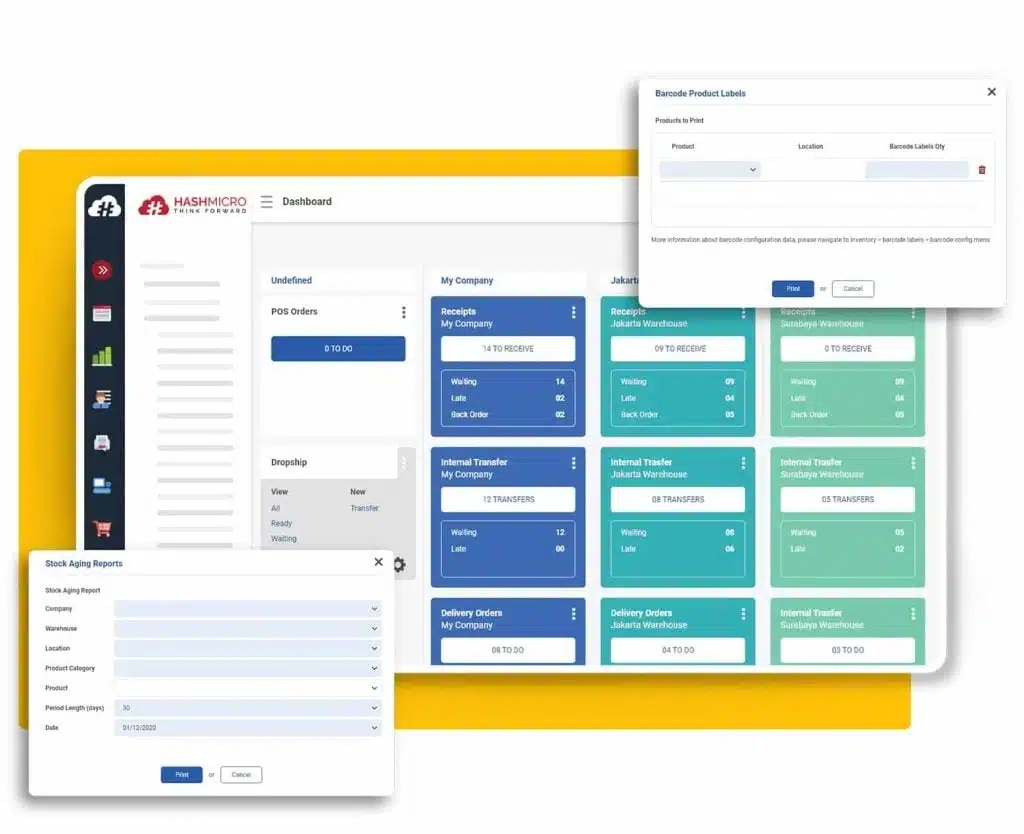Are you still relying on outdated and manual methods to manage your warehouse inventory? That’s a recipe for falling behind in this age of technology. The truth is traditional inventory management won’t cut it anymore.
Modern businesses in the Philippines are staying competitive by using advanced cloud inventory systems. Leading modern businesses use cutting-edge solutions that make a difference. If you’re serious about scaling your business, it’s time to adopt these top practices for 2025. Read on to discover how!
Key Takeaways
|
Table of Contents
What is Warehouse Inventory Management?

Warehouse inventory management is more than just storing goods; it’s about tracking, auditing, and managing stock efficiently. Using a modern system in your business will help you meet customer demands, reduce costs, and avoid stock issues
The main goals of warehousing and inventory management are to keep the right amount of stock, improve warehouse efficiency, and track stock accurately. It also aims to reduce old stock and make sure orders are fulfilled correctly to please customers.
With real-time tools for forecasting and analysis, these systems streamline restocking and improve overall operations. A good inventory system boosts efficiency and profitability, keeping businesses competitive.
Why is it Important?
Warehouse inventory management is vital for smooth logistics, helping businesses meet customer needs and improve order accuracy. Streamlining tasks such as picking, packing, and shipping boosts productivity, reduces errors, and ensures operations run efficiently.
Fast shipping and deliveries are essential in today’s age, where every customer demands them, and good inventory management, including effective inventory aging practices, helps meet these expectations. By analyzing inventory aging, businesses can identify slow-moving items and optimize stock levels to improve order fulfillment and reduce unnecessary storage costs.
Effective inventory management also saves money by optimizing storage and reducing waste through accurate demand forecasting. Maintaining the right stock levels, informed by inventory aging insights, prevents overstocking and stockouts, freeing up capital for business growth.
Techniques for Warehouse Inventory Management
If you are having a hard time recognizing some of the words we used previously, learn some of the techniques here to further enhance your knowledge in Inventory Management.
| Technique | Description |
|---|---|
| ABC Analysis | Categorizing inventory into three groups: high-value (A), medium-value (B), and low-value (C) items. |
| Perpetual Inventory Management | Provides real-time updates on stock levels, allowing businesses to maintain accurate inventory counts. Preventing stockout and overstock. |
| Economic Order Quantity (EOQ) | EOQ calculates the optimal order size to minimize total inventory costs and balance ordering and holding costs. |
| Safety Stock Inventory | Keeping extra stock as a buffer helps manage uncertainties like supply chain disruptions or unexpected demand spikes. |
| Batch Tracking | Monitors the movement of inventory batches, enabling efficient product recalls when necessary. |
| Dropshipping | Eliminating the need for storage and handling by shipping directly from suppliers to customers. |
| FIFO and LIFO | Manage stock rotation. FIFO (First In, First Out) is crucial for perishable items. LIFO (Last In, First Out) can be beneficial for tax purposes. |
| Just-in-time Management | JIT focuses on receiving goods only when needed, minimizing holding costs, reducing waste, and improving cash flow. |
| Cross Docking | Goods are quickly transferred from incoming to outgoing trucks, bypassing storage. Minimizing warehouse time and cost. |
Effective warehouse inventory management is key to better operations and lower costs. Using these methods can boost your inventory accuracy and order fulfillment. It also helps your financial health.

Warehouse Inventory Management Processes
Effective warehouse inventory management is crucial for smooth operations and success in the Philippines. A well-managed warehouse boosts productivity and enhances customer satisfaction by ensuring timely and accurate service.
These are the 5 processes you can follow:
- Warehouse Layout Optimization: A well-organized layout improves workflow by making goods easy to locate. Placing frequently picked items in easily accessible spots reduces walking time and boosts productivity.
- Warehouse Inventory Control Tracking and Recording: Accurate inventory tracking is essential for minimizing errors and improving demand forecasting. Tools like barcode scanners and RFID systems help ensure real-time, precise counts.
- Picking and Packing: Precise picking and packing are vital for customer satisfaction. Strategies like zone picking and handheld scanners can speed up the process and increase accuracy.
- Shipping: Efficient shipping connects the warehouse to customers. Advanced software helps manage carriers, track shipments, and ensure timely, accurate deliveries.
- Reporting and Optimizing: Regular reporting provides insights into warehouse operations, allowing for continuous improvements and problem-solving. This keeps operations efficient and cost-effective.
By prioritizing these key areas, your warehouse management will improve overall efficiency, reduce costs, and enhance customer satisfaction. Strong inventory control and optimized processes will help your business stay competitive and thrive in the Philippine market.
Challenges You Should Expect in Managing Warehouse
Businesses face various challenges in managing warehouse inventory, which can significantly impact their operations. Addressing these issues is crucial to improving inventory accuracy and making warehouses more efficient.
- Data Inaccuracy: Inaccurate data leads to mismanaged stock levels and misplaced orders, disrupting smooth operations and causing inefficiencies.
- Lack of Visibility: Limited visibility within the warehouse makes decision-making difficult, resulting in inefficiencies and increased operational costs.
- Warehouse Layout Issues: Poorly organized layouts waste space and slow down product movement, with labour costs consuming up to 65% of the budget.
- Manual Handling of Documents: Relying on manual documentation slows processes and increases errors, leaving warehouses behind those that use modern technology like RFID and AI.
- Emerging Risks: New challenges, such as handling hazardous materials and fluctuating demand, along with shipping delays and labour shortages, create additional risks in warehouse management.
Addressing these challenges is crucial for maintaining accurate inventory and ensuring efficient warehouse operations. By overcoming these obstacles, you can improve productivity and remain competitive, particularly in this market.
Best Practices for Warehouse Inventory Management

Here we are at last. These are the 9 best practices you should follow to have better inventory management for your warehouse. Effective management needs the right practices and modern tech.
Let’s take a look at key strategies for top performance in your warehouse:
Minimize Manual Input
Reducing manual processes lowers the risk of errors and ensures more accurate data entry. Automating tasks with barcode scanners, RFID systems, or mobile devices speeds up inventory management and increases accuracy while minimizing human intervention.
Implement Cycle Counting
Cycle counting regularly checks small portions of inventory without disrupting daily operations. By conducting frequent counts, businesses can maintain inventory accuracy throughout the year and avoid large discrepancies during annual audits.
Ensure Popular Products Are Easy to Reach
Placing high-demand products in easily accessible areas reduces the time employees spend walking and picking orders. This speeds up the fulfillment process and improves overall warehouse productivity, resulting in faster shipping times.
Organize Your Floor Plan
A well-organized warehouse layout is critical for maximizing space efficiency. Utilizing storage systems like Vertical Lift Modules or Carousels can optimize space, freeing up as much as 85% of otherwise unused areas and improving workflow efficiency.
Utilize Demand Forecasting
Accurate demand forecasting helps maintain optimal stock levels, preventing overstocking or stockouts. By analyzing past sales data, businesses can align inventory with demand patterns and avoid excess inventory, reducing storage costs and waste.
Keep a Close Eye on Expiration Dates
Monitoring expiration dates is essential to minimize product waste. Using strategies like First In, First Out (FIFO) ensures older stock moves first, keeping products fresh and reducing the risk of expired goods.
Implement Quality Control
Quality control processes ensure that products meet required standards before they reach customers. Regular inspections and setting quality benchmarks prevent defective products from leaving the warehouse, protecting brand reputation.
Train Your Staff
Well-trained employees are key to efficient warehouse operations. Regular training on new systems, technology, and best practices ensures that staff can effectively manage inventory and use tools to their full potential.
Use a Warehouse Management System (WMS)
A robust Warehouse Management System centralizes warehouse operations, offering real-time insights and control. It supports different picking methods, streamlines workflows, and ensures better inventory accuracy, ultimately improving efficiency and reducing errors.
By implementing these best practices and leveraging a comprehensive WMS, your business can significantly boost productivity, accuracy, and customer satisfaction, hopefully driving overall success.
Effectively Manage Your Warehouse with HashMicro’s WMS

Effectively managing a warehouse is critical for smooth operations and customer satisfaction. With HashMicro’s Warehouse Management System (WMS), you can easily streamline processes and improve inventory control by integrating with inventory management software, ensuring optimal performance. Some of the features of this software are:
- Product Dimension Tracking: Measure the height, width, and weight of each item to optimize space usage and ensure efficient storage placement, reducing clutter and maximizing warehouse capacity.
- Location Dimension Management: Automatically calculate the dimensions of warehouse locations, ensuring that items are stored in areas best suited to their size, which helps prevent misplacement and improve inventory accuracy.
- Putaway Strategy Settings: Define storage strategies for newly received items, ensuring they are placed in optimal locations, which streamlines the process and boosts inventory organization.
- Putaway Capacity Checking: Check and record the capacity of received goods, then allocate them to appropriate bin locations, preventing overstocking and improving storage management.
- Warehouse Pallet Racking: Organize warehouse shelves by creating categories based on item type and function, making it easier to locate items and improving overall inventory control.
- Warehouse In-Depth Reporting: Generate detailed reports that provide insights into warehouse efficiency, helping to identify issues and optimize inventory management for better operational performance.
With a comprehensive WMS system software, you can streamline your warehouse, cut costs, and keep your customers happy with smoother, more efficient operations. That’s why HashMicro’s WMS is the ideal choice if you are looking to optimize warehouse management and achieve better results with easy-to-use features.
Conclusion
Warehouse inventory management is essential for maintaining operational efficiency and meeting customer expectations. Adopting modern systems and practices, such as automated inventory tracking and optimized layouts, can significantly improve accuracy and productivity.
To stay competitive, embracing the latest technologies and strategies that streamline warehouse operations is crucial. HashMicro’s WMS system software offers all the tools needed to optimize your warehouse management, improving performance and profitability. Try the free demo today and see how it transforms your warehouse!

FAQ Around Warehouse Inventory Management
-
How do you manage inventory in a warehouse?
Inventory is managed by tracking stock levels, organizing layouts, and using systems like barcode scanners or WMS. Automation helps streamline processes, improving accuracy and reducing errors.
-
Why is inventory and warehouse management important?
Effective management ensures the right stock is available to meet customer demands on time. It reduces costs, prevents stockouts, and boosts operational efficiency.
-
What is the role of warehouse inventory management?
Warehouse inventory management oversees stock tracking, auditing, and optimizing storage for efficient operations. It ensures accurate orders, timely deliveries, and cost-effective processes.




































